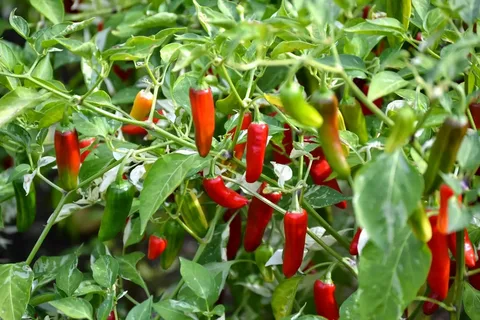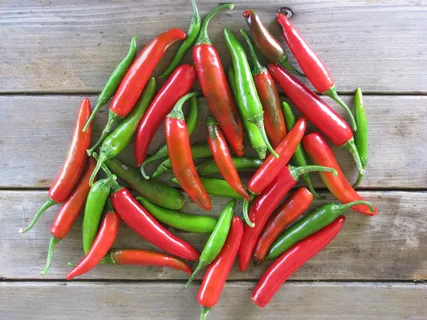Introduction
Serrano pepper are a variety of chili peppers that evolved in the mountains of Mexico’s Puebla and Hidalgo provinces. The name’serrano’ refers to the mountains (sierras) in these locations. They are little but powerful in terms of heat, scoring between 10,000 and 23,000 on the the Scoville scale. This puts them in the medium-heat category for chilies, hotter than jalapeño but not as fiery as habanero.
Serrano pepper are normally green, but they can grow into red, brown, orange, and yellow. They are two to four inches in length and have a refreshing, crisp flavor. Serrano peppers are widely used in salsa, pico de gallo, and other spicy recipes. They can be consumed raw or cooked, and are commonly used in sauces, marinades, and chili.
What are Serrano peppers?
Serrano peppers are prominent in both Mexican and Thai cuisine. This pepper is called for the mountainous region of Mexico where it first grew.
These peppers can vary in appearance depending on how developed they are in the developing process. For example, most unripe serrano pepper plants are greenish while expanding, but as they mature, they can be green, yellow, orange, or red.
Serrano chili peppers can be anywhere from one to three inches long. They are classified into three types: hidalgo, serrano, and hot rod, each of which can vary in size.
How To Use Serrano Peppers
Serrano peppers can be consumed roasted, pickled, raw, sliced, diced, or pureed; they can also be used to make a superb chile oil. The stem is not eaten, and most of the heat is stored in the seeds and interior flesh, which can be removed for a more mild experience. The peel is thin and edible, and it is not usually removed.
When making serrano peppers at home, proceed with caution. Chile oil produced by cutting, seeding, or harvesting hot peppers causes a burning sensation, mainly when applied to the face. When preparing serranos, use kitchen glasses and thick rubber gloves, and do not remove them until all preparation is finished and the tools and surfaces have been washed. When in contact with chiles, do not touch your eyes, mouth, or other parts of your face. If you’re analyzing or pureeing the peppers, keep your face away from the appliance after it’s opened. Pepper spray is made by pureeing hot chili peppers in a closed atmosphere, which can emit unpleasant odors when initially opened.
What Does Serrano Pepper Taste Like?
Although several types of peppers may appear similar, many have diverse flavors and levels of spiciness. Serrano peppers have a bright and spicy taste, akin to green chilies like jalapeños. Because of their high heat, you should experiment with them gradually rather than adding them all at once to a dish.
When to pick Serrano peppers?
Unripe serrano peppers start green and often develop to be 3 or 4 inches long on the plant. You can select and eat chile peppers at any stage of their growth, but the flavors will change as they develop.

Serrano pods eventually cease developing and change color, going from green to red, brown, orange, or yellow. After that, they will fall off the plant and may even rot on the plant, so select your serrano peppers when they are still greenish or as they begin to turn color.
When they are ready, they will readily snap off the plant with minimal resistance. I sometimes enjoy leaving the serrano pods on the plant for more extended periods to allow them to change color. They have a somewhat sweeter flavor, and the colors can really make a dish stand out visually.
The origins of the serrano
Serrano peppers are native to Mexico’s Sierra Madre mountains. The name itself is a reference to the mountains, as “mountain range” is “sierra” in Spanish. Since its inception, it has been a mainstay of Mexican cuisine. Today, it is one of the most common peppers in this region.
Sierra Madre Mountains
However, serranos are not only famous in Mexican cuisine. They are also a popular ingredient in many Southeast Asian recipes. These peppers can be grown in the southern United States. If you wish to produce peppers in a northern state, you’ll need to do them inside.
In 2019, the Chile Pepper Institute in New Mexico identified a new variety of serrano peppers that are gentler yet larger. They dubbed this pepper the NuMex CaJohns Serrano after John Hard of CaJohns Fiery Foods.
Growing Serrano peppers
Serrano peppers are often regarded as not only one of the most accessible peppers but also one of the easiest to cultivate. The serrano, like other peppers, thrives best in warm regions with temperatures above 75 degrees Fahrenheit. Because of this, frost can be exceedingly damaging to their growth. Serrano peppers thrive in soil with a pH ranging from 7.0 to 8.5, and the average pepper plant can reach five feet tall and produce up to 50 serrano peppers.
If you plan to cultivate your serranos, make sure you have enough drainage. Peppers grow best in soil with plenty of organic matter but not too much nitrogen.
Cooking with Serrano Peppers
This pepper is quite popular in Mexico, and it is a true mainstay in Mexican cuisine. This chili pepper’s skin is fragile and has a crisp, clean feel, making it suitable for raw consumption. They are neither waxy nor thick, like poblano peppers. They make great salsa peppers, especially as an alternative to jalapeño in salsa verde. They do not need to be peeled; chop them and mix them into the salsa right away. Serranos are also excellent when served raw with sandwiches, salads, soups, or stew.
We are also big lovers of pickled serranos. This chili works nicely with pickling, and its green, sharp flavor complements the vinegar tang. Serve these pickled peppers on sandwiches, salads, or as a side dish with grilled meats.
Serrano peppers are spicy without becoming overwhelming.
You now know that a serrano chili pepper has just the appropriate amount of heat to spice up your recipes. It won’t numb your palette as much as a habanero, but there are ways to make it less spicy. In addition to Mexican cuisine, try a variety of dishes with raw, grilled, or pureed serranos!
Conclusion
To summarize, serrano pepper is a versatile spice that gives intense flavor and heat to a wide range of recipes. Whether you’re making a hot salsa, a scorching curry, or a zesty salad dressing, the bright flavor of serrano pepper will satisfy your taste buds. Embrace the culinary adventure and use this tasty chili pepper in your following recipe!
